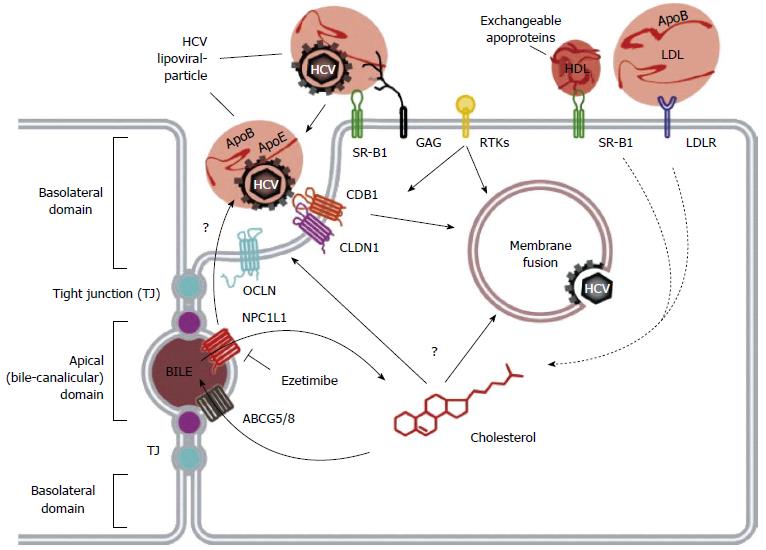Copyright
©The Author(s) 2015.
World J Gastroenterol. Jul 21, 2015; 21(27): 8293-8303
Published online Jul 21, 2015. doi: 10.3748/wjg.v21.i27.8293
Published online Jul 21, 2015. doi: 10.3748/wjg.v21.i27.8293
Figure 1 Hepatitis C virus viral life cycle.
Hepatitis C virus (HCV) entry into human hepatocytes is a complex, multi-step process that takes place at the basolateral region of polarized hepatocytes. It begins when the viral particle binds surface glycosaminoglycans (GAGs) and the low-density lipoprotein receptor (LDLR) via apolipoprotein E. This is followed by a complex series of interactions mediated by cellular factors including scavenger receptor class B type I (SR-BI), the tetraspanin CD81, claudin-1 (CLDN1), occludin (OCLN), the Niemann-Pick C1-like 1 (NPC1L1) receptor, as well as receptor tyrosine kinases (RTKs) that promote CD81-CLDN1 association and membrane fusion. The HCV particle is then internalized into the hepatocyte by clathrin-mediated endocytosis. This figure is reproduced with permission from the original article, published in Journal of Hepatology, Vol 57, Issue 1, by Lupberger J, Felmlee J and Baumert TF. Cholesterol Uptake and Hepatitis C virus entry, page 215-217, Copyright Elsevier, 2012.
Figure 2 Hepatitis C virus-mediated perturbations in cholesterol metabolism.
HCV: Hepatitis C virus; ROS: Reactive oxygen species; VLDL: Very low-density lipoprotein.
- Citation: Simon TG, Butt AA. Lipid dysregulation in hepatitis C virus, and impact of statin therapy upon clinical outcomes. World J Gastroenterol 2015; 21(27): 8293-8303
- URL: https://www.wjgnet.com/1007-9327/full/v21/i27/8293.htm
- DOI: https://dx.doi.org/10.3748/wjg.v21.i27.8293










